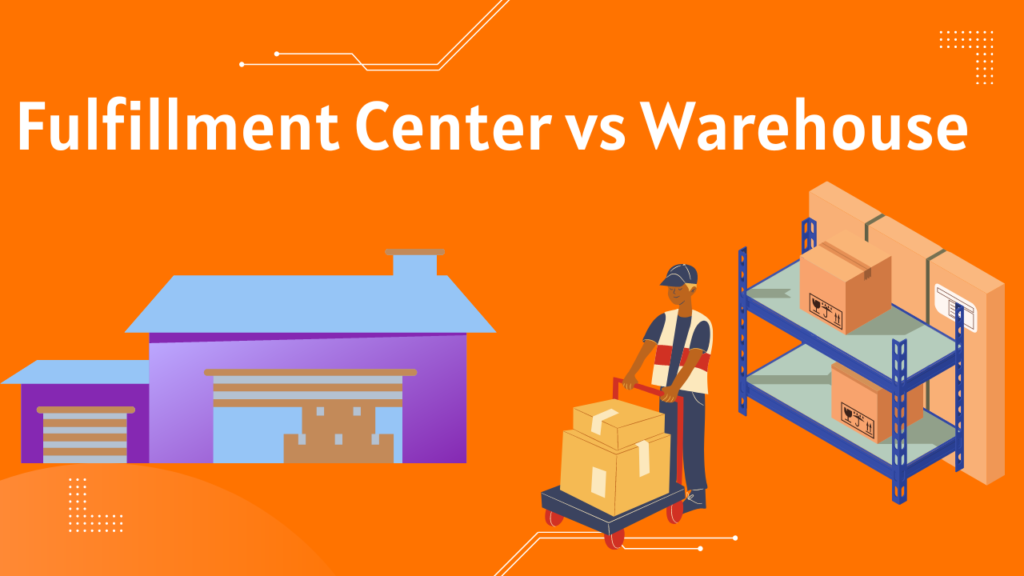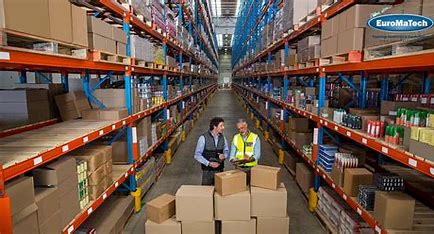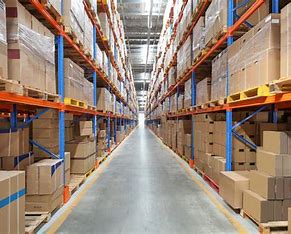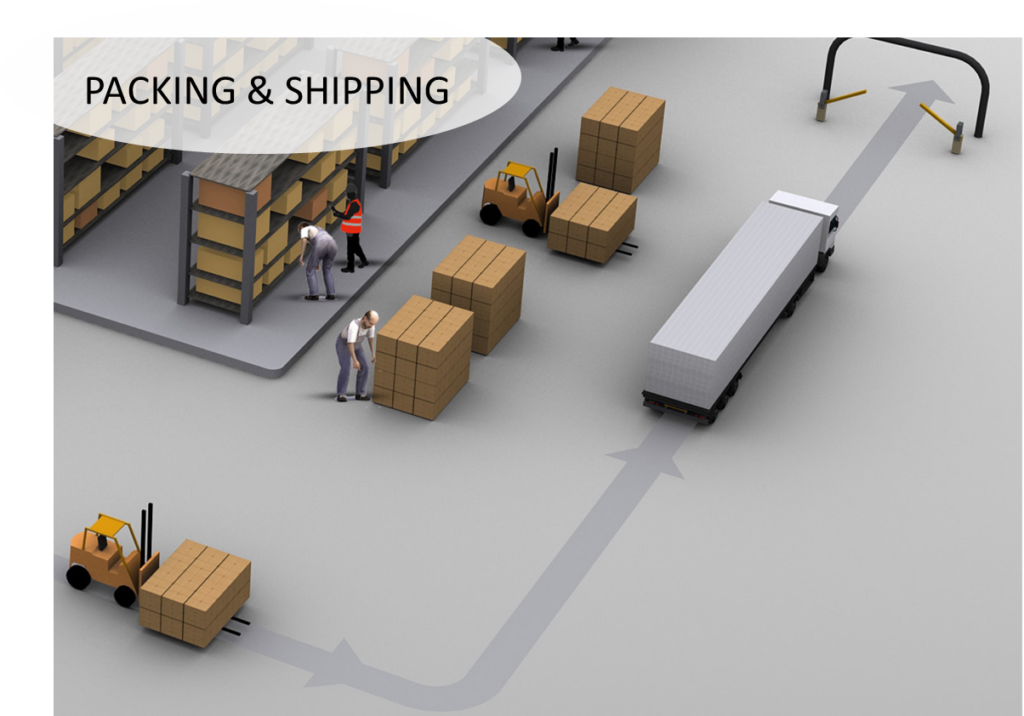In the world of logistics, a warehouse is a well-known term. It is a space meant to store products effectively and efficiently. These days, however, the concept of a fulfillment center vs warehouse has emerged. Although both seem similar, they differ in their functionality and purpose. If you’re an eCommerce business owner looking to store or fulfill your customer orders, you need to know the differences between the two. This article delves into the specific elements that differentiate a fulfillment center from a warehouse.
Fulfillment Center vs. Warehouse: What are the Differences?

When it comes to the world of logistics and supply chain management, there are many different terms and concepts that can be confusing to those who are not familiar with the industry. Two terms that are often used interchangeably, but actually have distinct differences, are fulfillment centers and warehouses.
As mentioned, a warehouse is primarily a storage facility designed to hold inventory for an extended period. Warehouses are typically large, open spaces that can accommodate a variety of products, from small items like electronics to large items like furniture. They are often located in industrial areas and are designed to be easily accessible for trucks and other vehicles that need to load and unload goods.
On the other hand, a fulfillment center is a facility that is specifically designed to handle the process of receiving, picking, packing, and shipping customer orders directly to their locations. Fulfillment centers are typically located closer to urban areas to allow for faster shipping times and are often much smaller than warehouses. They are also equipped with technology and automation systems that allow for efficient order processing and tracking.
While both warehouses and fulfillment centers serve the purpose of storing and managing inventory, the key difference lies in their primary function. A warehouse is primarily focused on storage, while a fulfillment center is focused on order fulfillment and customer satisfaction. Fulfillment centers are designed to handle high volumes of orders quickly and accurately, while warehouses are more focused on keeping inventory organized and accessible for future use.
It is important to understand the differences between these two types of facilities when considering your logistics and supply chain management needs. Depending on your business model and goals, you may need one or both of these types of facilities to effectively manage your inventory and fulfill customer orders.
Overall, the key takeaway is that while warehouses and fulfillment centers may seem similar on the surface, they serve different purposes and have different functions within the supply chain. Understanding these differences can help you make informed decisions about your logistics strategy and ultimately improve your business operations.
A Warehouse as Cost-effective Storage for Product Inventory

The primary purpose of a warehouse is to store products and inventory for extended periods. This type of storage is cost-effective because it does not require the regular movement of goods. A warehouse serves as an intermediary point between the manufacturer and the customer.
Warehouses have been around for centuries, and they have played a critical role in the growth of the global economy. They are essential for businesses that need to store large quantities of products without incurring high costs. A warehouse is a building that is designed to store goods and merchandise. It is equipped with loading docks, forklifts, and other equipment that makes it easy to move goods in and out of the facility.
In a warehouse, you can store your products until orders arise. This way, you can take advantage of bulk purchases, store your inventory in containers and cargo hold, and prepare for future deliveries successfully. You can also lease warehouse space depending on the specific needs of your business, making it a great option for eCommerce businesses that need flexible storage options that reduce overhead costs.
One of the benefits of using a warehouse for storage is that it allows you to keep your products safe and secure. Most warehouses are equipped with security systems that monitor the facility 24/7. This means that you can rest assured that your products are safe from theft and damage.
Another advantage of using a warehouse is that it allows you to streamline your operations. When you store your products in a warehouse, you can easily track your inventory levels and ensure that you always have the products you need on hand. This can help you avoid stockouts and ensure that you can meet the needs of your customers.
Finally, using a warehouse for storage can help you save money. When you store your products in a warehouse, you do not have to worry about the costs associated with maintaining your own storage facilities. This can help you reduce your overhead costs and increase your profits.
Long-term vs. Short-term Storage

When it comes to the storage of goods, businesses have to make a choice between long-term and short-term storage. Both options have their advantages and disadvantages, and the choice depends on the specific needs of the business.
A warehouse is a large, spacious building that is designed to store goods for an extended period. It is the perfect solution for businesses that need to store products for a long time. The advantage of a warehouse is that it allows businesses to anticipate future needs and respond to market changes quickly. By storing products in a warehouse, businesses can ensure that they have enough stock to meet demand when it arises. Additionally, a warehouse provides a reliable storage solution that can help businesses save money in the long run.
On the other hand, a fulfillment center is a facility that is designed to store goods for a short period. The primary purpose of a fulfillment center is to process incoming orders and ship them to customers as quickly as possible. As a result, the inventory held in a fulfillment center is constantly changing, and the focus is on storing goods for short-term use. The advantage of a fulfillment center is that it can help businesses meet customer demands quickly and efficiently. By storing products in a fulfillment center, businesses can ensure that they have enough stock to fulfill customer orders in a timely manner.
In conclusion, the choice between a warehouse and a fulfillment center depends on the specific needs of the business. If a business needs to store products for a long time, a warehouse is the perfect solution. However, if the focus is on short-term storage and quick order fulfillment, a fulfillment center is the way to go. Regardless of the choice, businesses need to ensure that they have a reliable storage solution that can help them meet customer demands and respond to market changes quickly.
One of the primary benefits of using a fulfillment center is the ability to streamline your order fulfillment process. By outsourcing your order fulfillment needs, you can free up valuable time and resources that can be used to focus on other aspects of your business. This can include marketing, product development, and customer service, which are all critical components of a successful eCommerce business.
Another advantage of using a fulfillment center is the ability to scale your business quickly and efficiently. As your business grows, you may find that your current order fulfillment process is no longer sufficient to meet the demands of your customers. By partnering with a fulfillment center, you can quickly ramp up your order processing capabilities to meet the needs of your customers, without having to invest in additional warehouse space or personnel.
In addition to streamlining your order fulfillment process and scaling your business, a fulfillment center can also help you save money. By outsourcing your order fulfillment needs, you can take advantage of the economies of scale that come with working with a large, experienced fulfillment provider. This can include discounted shipping rates, bulk packaging discounts, and more.
Finally, using a fulfillment center can also help you improve your customer satisfaction rates. By working with a professional fulfillment provider, you can ensure that your orders are processed quickly and accurately, and that your customers receive their orders in a timely manner. This can help you build a loyal customer base and improve your overall reputation in the industry.
In conclusion, a fulfillment center is an essential component of any successful eCommerce business. By outsourcing your order fulfillment needs, you can streamline your order processing, scale your business, save money, and improve your customer satisfaction rates. So if you’re looking to take your eCommerce business to the next level, consider partnering with a professional fulfillment provider today.
Manual Process of Picking, Packing, and Shipping

A fulfillment center has the manual process of picking, packing, and shipping items to the customer. This process involves order management software that enables warehouse employees to input and consolidate incoming orders.
Once an order is received, a picker assigns the order to a specific picker, who then scans and locates the product, picks it up, and sends it to the packing station. The packer confirms the product’s quality, packs it in a box with packaging material, and moves it to the shipping department, where it is labeled and sent off to the customer according to their location.
Assessing the Pros and Cons of Each
It is essential to weigh the pros and cons of each option when deciding on the best option for your business. For instance, a warehouse offers cost-effective storage for businesses that do not need to process and ship orders frequently. In contrast, a fulfillment center offers quick and efficient order fulfillment, which can be beneficial for fast-paced eCommerce businesses.
However, while a warehouse can offer a cost-effective storage solution, it often requires manual labor to fulfill orders, making it time-consuming, and could negatively impact the customers’ experience. In contrast, automation and software employed in a fulfillment center can help process large volumes of customer orders more efficiently and with fewer errors.
Also checkout more importance’s of the Fulfillment Companies
Calculating the Space Requirements for Each
Another consideration when choosing between a warehouse and fulfillment center is the space requirements. A warehouse requires more space for storing goods, with minimal warehouse workstation requirements, while a fulfillment center requires more space due to the need to configure packing and shipping workstations.
Space requirements will depend on the number of orders received, types of products stored, and the frequency of orders processed.
Analyzing the Speed and Efficiency of a Fulfillment Center vs. A Warehouse

When it comes to analyzing the speed and efficiency of a warehouse versus a fulfillment center, the latter is the most efficient option. With automation and software, order processing and shipping can be done more quickly, creating satisfied customers. On the other hand, the manual labor involved in a warehouse can slow down the order fulfillment process significantly, leading to negative customer experiences.
A fulfillment center is designed to better manage incoming product orders and anticipates customer expectations but demands larger upfront investment costs than a warehouse that favors long-term storage and infrequent product movement.
Final thoughts
In conclusion, both a warehouse and a fulfillment center serve different purposes, and success depends on the specific needs of businesses. If your business requires flexibility in storage needs, cost-effective storage options and is not concerned with rapid product processing, a warehouse could be the best option. However, if your business aims to improve order fulfillment speed, accuracy, and customer satisfaction, a fulfillment center is the best choice. It is crucial to weigh the pros, cons, and determine the space and speed requirements of each option when considering the best choice for your business.
